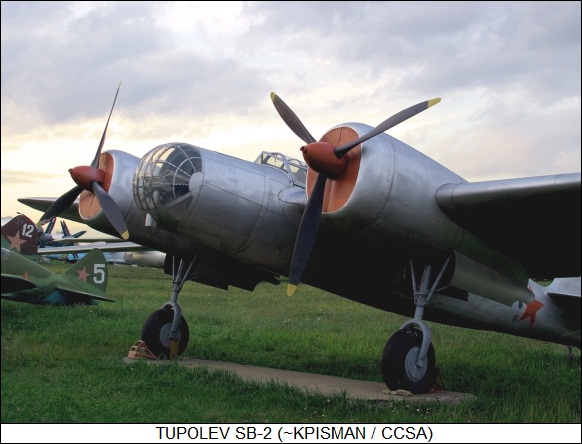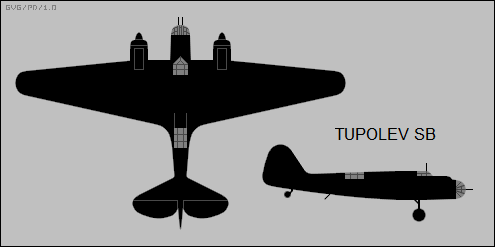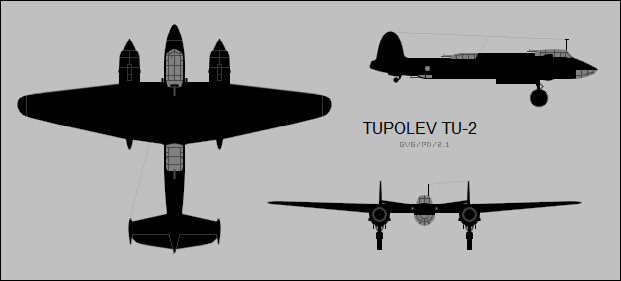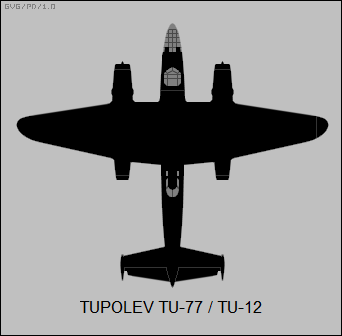
* Andrei N. Tupolev was one of the most important Soviet aircraft designers from the early days of the USSR, originally achieving prominence through the development of giant machines that were flying Red propaganda pieces. However, his design organization performed other contributions to the Soviet Union, including the "SB" bomber -- an advanced aircraft by prewar standards -- and its "Tu-2" successor, which contributed to the defeat of the Germans. This document provides a history and description of the SB and Tu-2.

* In the early 1930s, the bombers operated by the VVS (Voyenno Vozdushniye Sily / Red Air Force) were too slow to defend themselves from fighter attack. After the VVS issued a requirement for a bomber fast enough to take care of itself, in early 1934 the experimental design bureau (OKB in its Russian acronym) led by Andrei N. Tupolev came up with a proposal for a twin-engine monoplane bomber, with the design given the OKB designation of "ANT-40", where "ANT" stood for Tupolev's initials. The actual design work was done by a team under Alexander A. Archangelskiy.
Following discussions, the VVS issued a more specific requirement to detail what was expected of the ANT-40. It was to have a maximum speed of 330 KPH (205 MPH), a service ceiling of 8,000 meters (26,250 feet), a range of 700 kilometers (435 miles), and a bombload of 500 kilograms (1,100 pounds). Defensive armament was to consist of a pair of 7.62-millimeter ShKAS machine guns in the nose, plus a ShKAS machine gun on a flexible mount in both the dorsal and ventral positions.
After fleshing out the design, authorization was granted for the construction of two prototypes, one with twin US-made Wright Cyclone air-cooled radials providing 545 kW (730 HP) each, and the other with French-made Hispano-Suiza 12Y vee-12 engines providing 580 kW (780 HP) each. The Cyclone-powered machine performed its initial flight on 7 October 1934; it was damaged on landing on 31 October and laid up for three months while it was being repaired. After returning to flight, it completed its trials at the end of July 1935, to then be assigned to experimental duties.
The Hispano-Suiza-powered machine performed its first flight on 30 December 1934. Although the inline engines were heavier than the radials and had required a larger wing on the second prototype, performance was outstanding, well better than spec. It too crashed on landing, on 3 March 1935, and was laid up for a time undergoing repairs. It returned to flight in April, and completed trials a year later.
* Even before completion of trials, plans were moving ahead on production of the ANT-40, under the designation of "SB" -- for "Skorostnoy Bombardirovschik / Fast Bomber". The inline-powered variant was selected for manufacture, with a handful of evaluation machines delivered from the spring of 1936. By November 1936, production aircraft were on display for the public, flying over Red Square.
BACK_TO_TOP* The SB was an all-metal monoplane with a mid-mounted wing, the layout of the flight surfaces and controls being conventional. It featured taildragger undercarriage, with all gear assemblies featuring single wheels, the main gear retracting backwards into the engine nacelles and the tailwheel being fixed. It was powered by twin Vladimir Klimov M-100 12-cylinder inline vee engines -- license-built derivatives of the Hispano-Suiza 12Y -- providing 560 kW (750 HP) each and initially driving two-bladed fixed-pitch props. The engines featured unusual "honeycomb" front radiators that suggested a radial-engine installation.

Twin ShKAS machine guns with 1,000 rounds each were fitted in a dual position in the nose, along with a ShKAS in a glassed-in dorsal position and with 1,000 rounds, and another ShKAS in a hatch in the rear fuselage with 500 rounds. All bombload was carried internally, with the maximum bombload being either one 500-kilogram (1,100-pound) bomb, or up to six smaller bombs for a total of 600 kilograms (1,320 pounds). Despite having three gun positions, there were only three crew: pilot, bombardier / nose gunner, and navigator / rear gunner.
__________________________________________________________________
TUPOLEV SB:
__________________________________________________________________
wingspan:
20.3 meters (66 feet 8 inches)
wing area:
56.7 sq_meters (610 sq_feet)
length:
12.27 meters (40 feet 5 inches)
empty weight:
4,060 kilograms (8,950 pounds)
gross weight:
5,628 kilograms (12,405 pounds)
maximum speed:
395 KPH (245 MPH / 210 KT)
service ceiling:
9,000 meters (29,500 feet)
range:
2,185 kilometers (1,360 MI / 1,180 NMI)
__________________________________________________________________
Formally speaking, the initial variant was the "SB-2M100", which just meant "SB with twin M-100 engines". There had been some weight growth from the prototypes to the production machines, and so from late 1936 SBs were built with upgraded M-100A engines with 640 kW (860 HP), resulting in a distinct boost in performance. The improved bomber was of course designated "SB-2M100A".
Combat experience demonstrated the need for various minor improvements, such as rearranging the cockpit. Development of the still more powerful Klimov M-103 engine, with 715 kW (960 HP) suggested that even more changes might be made, resulting in a series of developmental prototypes with various confusing designations, and introduction of the new "SB-2M103" production model in mid-1938. Along with the new engines, which drove three-bladed variable props and had a more conventional radiator system, the SB-2M103 had various other improvements, most significantly external underwing bomb racks, permitting an increase in bombload by 500 kilograms (1,100 pounds). Late production machines appear to have been fitted with a proper dorsal turret and had a ventral tub for the belly machine gun, instead of just shoving the weapon out through a hatch in the floor.
* The SB was in action very early in its career. With the outbreak of the Spanish Civil War in 1936, Soviet dictator Josef Stalin decided to aid the Left-leaning Spanish Republican government -- for a stiff price. The Soviets did deliver aircraft to the Republicans, including SB bombers, a total of about 70 being supplied. The opposing Spanish Nationalists and their German "volunteer" allies found the SB a nasty surprise, able to easily evade their fighters. The Nationalists finally won in the spring of 1939 and surviving SBs ended up in Nationalist hands, lingering in operation to 1950.
In 1937, a license-production deal for the SB was signed between the Soviet and Czechoslovak governments, with Czech-made SBs to feature locally-built Hispano-Suiza engines and machine guns of Czech design. Initial deliveries of Soviet-built aircraft to precede Czech production were supposed to begin in 1938 -- but due to various bureaucratic hangups, no SBs ended up in Czech hands before the Nazis completely occupied the country in March 1939. Several dozen SBs were supplied to the Chinese Nationalist Air Force during that timeframe as well.
In the meantime, in 1938 the USSR had fought a border war with the Japanese in the Far East, with a second and more intensive round of fighting in the summer of 1939 -- Soviet successes in these clashes leading to a rapprochement with the Japanese and cooling of Soviet relations with the Chinese Nationalists. The SB also acquitted itself well in the conflicts, but this was the effective zenith of the type. Aircraft design was proceeding very rapidly in the 1930s, and a machine that had been leading-edge in 1934 was fatally obsolescent five years later.
Production of the SB continued, however, with over 6,600 built. At the outbreak of the war in Europe in September 1939, the SB was not only the most common bomber in Red Air Force service, it was likely more common than any other bomber in the world. Over 1,400 were available at the time of the German invasion on 22 June 1941; they survived the initial Luftwaffe blitz on Soviet airfields better than most combat types, being based farther to the rear, but they suffered terribly in attempts to slow down the invaders. The Germans found the SB "lit up" very quickly under fire, due to its lack of fuel-system protection.
Losses were then considerably reduced by going to night attacks, though bombing accuracy suffered as well. As better bombers were introduced, the SB was gradually relegated to rear-area transport operations, flying on in a lingering fashion through the war. The Germans and Finns also operated some captured SBs as utility machines. Despite the large number of SBs built, the type remains largely forgotten -- probably because those who had anything to do with it didn't want to remember it.
* Some sources indicate that a transport variant of the SB was built, with M-100 powered machines given the designation "PS-40" and M-103 powered machines given the designation "PS-41". However, sources are not consistent on the matter and it is unclear if they were actually rolled out as transports, or were some sort of conversion from bombers. A few "USB" trainers with a secondary cockpit and dual controls are known to have been built.
Archangelskiy made several efforts to improve on the SB. The "Archangelskiy MMN" was flown in 1940, but turned out to have no advantage over the SB and was quickly abandoned. Incidentally, it seems that the Archangelskiy name was being used because in 1937 Tupolev had been arrested for "treason" -- the USSR under Stalin had a frighteningly broad definition of the term -- and for the moment he was discredited.
Archangelskiy went back to the drawing board and came up with a substantially more modernized machine, the "Ar-2", with more powerful engines in streamlined nacelles, revised wings and nose, and dive brakes -- the Soviets were big on dive bombing at the time. Two prototypes were built, with initial flight in October 1940. It was put into limited production, with about 190 being built, but the comparable Petlyakov Pe-2 bomber was felt to have more potential and the Ar-2 was sidelined. Archangelskiy worked on a final variant, the "SBB", that had a significant resemblance to the Pe-2; however, the Pe-2 was still judged superior, and Archangelskiy was reassigned to other duties.
BACK_TO_TOP* Tupolev's incarceration didn't precisely mean he was out of his job. Lavrenti Beria, the feared head of the NKVD security service, had a practical streak, and saw no reason to discard assets even if they were officially traitors. Beria set up a number of "technical prisons" -- nicknamed "sharashkas" or "sharagas" -- where researchers could continue to do work for the Soviet state under guarded conditions. Tupolev became the technical boss of one such organization, which became known as the "Tupolev sharashka".
In 1938, when the SB was beginning to clearly show its age, the Soviet government issued a specification for a replacement -- a fast bomber with internal bomb storage and good performance. Tupolev's group responded with a tidy twin-engine aircraft with the designation "ANT-58". Following inspection of a mockup, the state authorities ordered the construction of prototypes of the "Aircraft 103", as it was initially designated.
The first 103 prototype made its initial flight on 29 January 1941. The bomber was powered by twin Mikulin AM-37 vee-12 liquid-cooled engines with 1,045 kW (1,400 HP) each, in close-fitting cowls and driving a three-bladed variable-pitch propeller. The prototype's performance was spectacular, with a top speed of 635 KPH (395 MPH), range of 2,500 kilometers (1,550 miles), and ceiling of 10,600 meters (34,800 feet).
The second prototype, the "ANT-59" or "103U", flew in May 1941. Tests of the two prototypes went well and the type was approved for production, but there was a problem: the AM-37 engines were troublesome and clearly not ready for production, so an alternative powerplant would have to be selected. A third prototype, the "ANT-60" or "103V", was fitted with M-82 14-cylinder air-cooled two-row radials, with 990 kW (1,330 HP) each. The ANT-60 first flew in December 1941, when the Germans were at the gates of Moscow.
The radial engines offered less power and performance was reduced accordingly, but at least they worked reliably. Three pre-production aircraft, now with the designation Tu-2, were delivered to a bomber regiment in September 1942 for combat evaluation, and the aircrews proved enthusiastic about the type. Production was authorized, with the design tweaked to improve manufacturability.
__________________________________________________________________
TUPOLEV TU-2:
__________________________________________________________________
wingspan:
18.86 meters (61 feet 10 inches)
wing area:
48.8 sq_meters (525 sq_feet)
length:
13.8 meters (45 feet 3 inches)
height:
4.55 meters (14 feet 11 inches)
empty weight:
7,475 kilograms (16,475 pounds)
gross weight:
10,360 kilograms (22,840 pounds)
maximum speed:
550 KPH (340 MPH / 295 KT)
service ceiling:
9,500 meters (31,200 feet)
range:
2,100 kilometers (1,305 MI / 1,135 NMI)
__________________________________________________________________
Field deliveries of production Tu-2s were delayed, however, and full production Tu-2s did not reach line units until early 1944. The similar but smaller Petlyakov Pe-2 took production priority. In fact, production of the Tu-2 was even put on hold for a time -- until frontline officers said they needed the Tu-2, since it had greater range and bombload than the Pe-2.
The Tu-2 featured mid-mounted wings, a twin-fin tail, and taildragger landing gear. All gear assemblies featured single wheels: the main gear retracted back into the engine nacelles, while the tailwheel was retractable as well. The Tu-2 was fitted with twin ASh-82FN radials, providing 1,380 kW (1,850 HP) each.

The aircraft normally carried a crew of four: a pilot; a navigator, who also acted as a gunner and the bombardier; a radio operator, who also acted as a gunner; and a belly gunner. Defensive armament included three 12.7-millimeter (0.50-caliber) UBT machine guns on flexible mounts, with 250 rounds per gun. Offensive armament included two fixed forward-firing 20-millimeter ShVAK cannon, one in each wing root, with 200 rounds per gun, plus 1,000 kilograms (2,200 pounds) of bombs in the bomb bay and racks for 2,000 kilograms (4,400 pounds) more under the wings inboard of the engines.
A total of 1,111 Tu-2s was delivered before the end of hostilities. Late production machines featured a number of minor improvements, most notably four-bladed props, and were designated "Tu-2S", though they remained closely similar to earlier production machines.
BACK_TO_TOP* The Tu-2 remained a front-line aircraft after the war, with 1,416 more built up to the end of production in 1948. The type was supplied to Poland and China, and saw limited action in the Korean War. NATO assigned the Tu-2 the reporting name "Bat". A number of different experimental variants were built during the war and afterward, though none reached full production:
From 1944 there was work on a fast bomber derivative of the Tu-2 designated the "SDB" (for "skorostnoy dnevnoy bombardirovschik / fast day bomber"), with more streamlining, lighter defensive armament, and AM-39 inline vee engines with 1,395 kW (1,870 HP) each. Performance was excellent, but the design engineers felt that a general upgrade of the Tu-2S with the AM-39 engines was a better idea.
That improved Tu-2S, designated "Tu-10", was built in small numbers. A more substantial revision of the basic Tu-2S, the "Tu-8", retained the M-82FN engines but had a new nose, a side-by-side cockpit, barbette turrets with a single 20-millimeter cannon replacing the handheld UBT guns, and a bigger wing. However, in the postwar period jets were seen as the way of the future, and by 1947 all interest in a piston-powered follow-on to the Tu-2 had evaporated.

* The Tu-2 was used to test jet engines, attached under the center fuselage, being flown with captured German BMW 003 turbojets, as well as Rolls-Royce Derwent and Nene turbojets purchased under an agreement with the British. The Derwent was built by the Soviets as the RD-500, the Nene was built as the RD-45; the RD-45 would power the MiG-15 fighter and the Il-28 bomber. One Tu-2 was actually fitted with twin RD-45s, replacing the piston engines, on an experimental basis, as a demonstrator for a jet derivative of the Tu-2.
Development of this derivative began in 1946 under the OKB designation of "Tu-77". It featured a heavily revised airframe; it had a fully glazed nose and tricycle landing gear -- probably because jet aircraft tended to tear up the tarmac if they were fitted with tailwheel landing gear. Details of this machine are not at all clear, but sources indicate that initial flight of the first prototype was in June 1947, with about 50 "Tu-12" production machines built.

Span was 18.86 meters (61 feet 10 inches), length was 16.45 meters (64 feet), while empty weight was about 8.9 tonnes (9.8 tonnes). Maximum speed at altitude was about 780 KPH (490 MPH). Armament included an NR-23 23-millimeter cannon fixed in the nose and a UBT 12.7-millimeter machine gun on flexible mounts in both dorsal and ventral positions. Although it may have been intended as an operational machine, in practice it was strictly flown in the evaluation role.
BACK_TO_TOP* As a footnote to the Tu-2 story, Soviet aircraft designer Pavel Sukhoi, famed for his postwar jet fighter designs, ran an OKB during World War II. Sukhoi had very poor luck getting any of his designs from that era into production, and his OKB would be disbanded after the conflict -- to be revived, with excellent results, a few years later.
The only one of Sukhoi's designs from the first incarnation of his OKB that proved noticeably successful was the "UTB-2", where "UTB" stood for "uchebno trenirovochniy bombardirovshchik" or "bomber trainer". It was derived from the Tu-2 and could be easily confused for it at a glance, but though it did incorporate Tu-2 elements it was a distinctly different aircraft, what might be called a "Tu-2 Lite". It was stripped of armor and other combat kit not needed for training, with only a single 12.7-millimeter UBT machine gun in the dorsal position for defensive armament; it didn't even have a bomb bay, with a light bombload carried on belly racks when necessary. It had a widened cockpit to provide side-by-side seating for trainee and flight instructor.
Being substantially lighter than the Tu-2, it was powered by twin Shvetsov ASh-21 seven-cylinder air-cooled radial engines, with 520 kW (700 HP) each, driving two-bladed variable propellers. Performance was correspondingly modest, top speed being about 380 KPH (235 MPH), but that wasn't a big concern for a trainer. The landing gear was also made lighter, since it didn't have to handle as much weight. The first UBT-2 flew in 1946, with some number -- exactly how many is unclear, sources claim "several hundred" -- built and going into service with the VVS, as well as the Polish Air Force. The UBT-2 could also be used as a target tug, towing a sleeve target. It served into the mid-1950s.
* As usual, trying to nail down details of Soviet aircraft is troublesome. The Soviets were always secretive -- and when they did release details, they were often deliberately misleading. As a result, the historical record is necessarily muddy and confused. It gets a bit tiresome working on them.
* Sources include:

* Revision history:
v1.0.0 / 01 mar 09 v1.0.1 / 01 feb 11 / Review & polish. v1.0.2 / 01 jan 13 / Added Sukhoi UBT-2 bomber trainer. v1.0.3 / 01 dec 14 / Review & polish. v1.0.4 / 01 nov 16 / Review & polish. v1.0.5 / 01 oct 18 / Review & polish. v1.0.6 / 01 aug 20 / Review & polish. v1.0.7 / 01 jun 22 / Review & polish. v1.0.8 / 01 may 24 / Review & polish.BACK_TO_TOP
